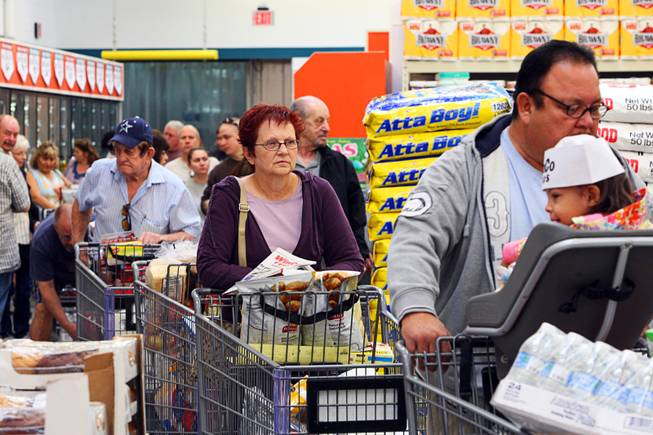
Sharon Massimino, center, waits in a checkout line during the grand opening a WinCo Foods supermarket at Stephanie Street and Wigwam Parkway in Henderson Sunday, March 4, 2012. The Boise-based supermarket chain opened their 81st and 82nd stores Sunday, their first stores in Southern Nevada.
Saturday, June 14, 2014 | 2 a.m.
Related story
The typical grocery store may look very different in the future, with super-fast checkouts, drive-up windows and touch-screen displays among the changes aimed at satisfying shoppers.
But while innovations such as super-speedy checkouts sound great to many people, they can also cut into some very profitable sales.
Self-checkouts, first used in 1992, now account for about 40 percent of transactions at grocery stores, according to Frank Jimenez, senior director of insights-driven performance and retail evolution at Hershey. But as they've grown more popular, products sold at the front of grocery stores, including candy bars, have taken a hit.
Jimenez estimates that billions of dollars in overall sales have been lost as people move through checkouts more quickly and do not linger at displays in the lanes.
Self-checkouts, he notes, have proven to be "an operational solution and a merchandising challenge."
He and other industry experts at this week's FMI Connect conference at McCormick Place are trying to prepare for what they see as the retail experience of the future. It could include everything from super-personalized shopping experiences to stores that transform based on the time of day.
For example, a store's glass entryway doors could lift up on a weekend morning to provide space for a farmers' market, according to Tre Musco, president and chief creative officer at Tesser, a brand strategy and design firm that participated in the industry group's research efforts.
Musco expects to see stores making better use of their space depending on the time of day. For example, a variety of prepared deli items could be brought to the front of a store on a sliding display at around 4 p.m. on weekdays, in order to appeal to shoppers looking for that night's supper.
Several people envision stores that would be more like an Apple store, with capabilities such as instant payment, bypassing long checkout lines.
"We're saying that a day comes when you don't even need a front of the store," Jimenez said.
The checkout lines themselves are also getting faster, which cuts down on traditional opportunities to sell impulse items such as candy bars, gum and cold drinks.
Industry-wide, checkout lane sales account for about 2 percent of total store sales and roughly 4 percent of gross profits, Jimenez said.
High-speed scanners that are roughly three times faster than the traditional scanners are being tested by chains such as Cincinnati-based Kroger. And chains such as Wal-Mart allow shoppers to scan items with their mobile phones while they shop, which cuts down on the time they spend at check out.
Still, some say that new technology will help drive sales. Motorola Solutions sells handheld scanners to stores and is launching a new version in September that looks more like a smartphone, with a bigger touch screen.
The personal shopping device has helped lift revenue by 7 to 14 percent in some cases, according to product manager David Snook. Older versions of the device are in more than 2,000 stores, but for now they are more popular at grocery retailers in Europe than they are in the Midwest. Some chains on the East Coast, such as Stop & Shop, use the devices, Snook said.
Motorola Solutions declined to discuss the cost of its devices, but did say that the return on investment could come as quickly as 12 months to 24 months.

Join the Discussion:
Check this out for a full explanation of our conversion to the LiveFyre commenting system and instructions on how to sign up for an account.
Full comments policy